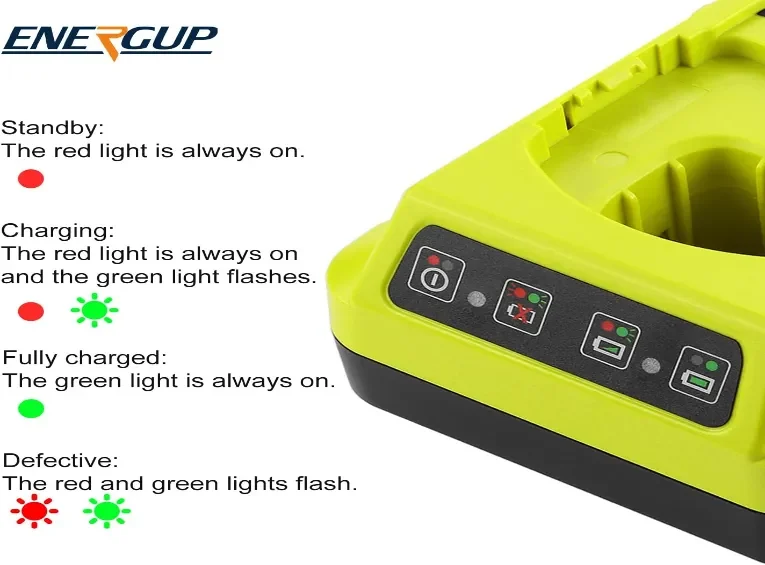Why Chargers Reject Most Aftermarket Ryobi One+ (18V) Packs
Chargers often reject aftermarket Ryobi One+ (18V) packs because the battery and charger fail to communicate properly — mechanically, electrically, or through the pack’s BMS (battery management system) and ID components. That mismatch triggers the charger’s safety logic and it refuses to deliver current. Understanding why this happens helps avoid wasted purchases and potential safety risks.

Why chargers refuse aftermarket Ryobi 18V packs
Modern lithium tool packs aren’t just rows of cells — they carry sensors, ID chips, and communication circuits. OEM Ryobi chargers run handshake checks before charging. If anything fails, the charger aborts. Common reasons include:
1. Proprietary identification / handshake
Ryobi packs often contain an ID resistor or chip. If the charger cannot read or validate it, charging won’t begin.
2. Charge profile mismatches
Chargers expect certain voltage rise and cutoff behaviors. Abnormal curves from aftermarket packs trigger rejection.
3. Incomplete or incompatible BMS
The BMS manages balancing and communication. If timing or protocols differ, the charger halts for safety.
4. Temperature sensor differences
Ryobi chargers rely on thermistor feedback. If wiring is missing, reversed, or out of range, charging is blocked.
5. Mechanical tolerance issues
Terminal length, angle, or plating variations cause poor contact, which the charger interprets as a fault.
6. Certification or firmware enforcement
Some chargers enforce UL/CE certification or firmware matching. Non-certified packs may be automatically refused.
7. Cell quality and resistance
Low-grade or aged cells sag under test pulses, causing the charger to stop and flag the pack as unsafe.
Quick LED reference (typical patterns)
| LED Pattern | Meaning |
|---|---|
| Solid Red | Charging normally |
| Solid Green | Fully charged |
| Flashing Red | Contact or pack fault |
| Alternating Red/Green | Temperature fault (too hot/cold) |
| Rapid Red flash / Red+Green together | Charger fault or end-of-life battery |
Always cross-check with your specific Ryobi manual. LED behavior varies slightly by model.
How to diagnose safely
-
Visual inspection — unplug the charger, inspect terminals, and clean with isopropyl alcohol.
-
Swap test — OEM pack in suspect charger, aftermarket pack in a different charger. Helps isolate pack vs. charger.
-
Observe LEDs — note exact blinking patterns for reference.
-
Measure open-circuit voltage (optional) — if skilled, compare against a known-good pack.
-
Temperature check — ensure the battery is at room temperature before charging.
-
Return/replace — if a pack consistently fails across chargers, request a return or documentation.
What not to do
-
Do not bypass or short the BMS.
-
Do not use adapters designed to trick the charger.
-
Do not attempt charger or pack rewiring — it’s unsafe and voids warranty.
Practical ways to reduce issues
-
Purchase only aftermarket packs with clear compatibility claims and certifications (UL, CE, IEC).
-
Ask for test reports or third-party reviews confirming OEM charger support.
-
Keep at least one OEM pack for reference and mission-critical tasks.
-
Return incompatible packs quickly rather than forcing them into service.
Safety and warranty implications
Rejection is part of the charger’s protection system. Forcing aftermarket compatibility risks fire hazards, tool damage, and denied warranty claims. In professional or safety-sensitive environments, OEM or proven aftermarket brands are the most reliable option.
FAQ
Q: Will aftermarket packs void my Ryobi warranty?
A: Yes, in many cases. If damage occurs, Ryobi may refuse coverage.
Q: My new aftermarket pack is rejected — is it defective?
A: Not always. Clean contacts and try multiple chargers. If it fails everywhere, it’s incompatible.
Q: Can firmware updates fix this?
A: No. Charger and BMS firmware are not user-updatable. Compatibility must be engineered by the pack manufacturer.
Conclusion
Ryobi chargers reject aftermarket packs when safety, communication, or quality checks fail. By understanding the causes and following a clear diagnostic process, you can quickly determine whether the issue lies with the pack or charger. When in doubt, choose OEM or certified aftermarket batteries to protect your tools and reduce downtime.